Investing in body armour for mountain biking is a wise move for anyone who rides fast or tricky descents.
Also known as pressure suits or back protectors, the options we've listed here provide protection for your back and spine, with some also including protection for your shoulders, elbows or chest.
Many riders opt for knee pads or elbow pads, but wearing torso protection is a good idea, too. After all, we never know when a crash is going to happen.
Fortunately, upper-body armour has become lighter and less restrictive compared to the bulky suits of years gone by.
Our pick of the best body armour for mountain biking includes options for all types of riding. Our expert team of independent testers have racked up hours of riding and considered protection, fit, comfort, extra features and price when scoring these products.
Finally, you should always wear a helmet when mountain biking, so check out our picks of the best mountain bike helmets and the best enduro helmets.
We have also included our buyer's guide to MTB body armour below.
Editor's note: this list was updated on 17 March 2025 with our latest high-scoring reviews. We have also included information on how we test mountain bike body armour and why you can trust BikeRadar.
Best MTB body armour in 2025
Fox Baseframe Pro Sleeveless Chest Guard
SQUIRREL_TEXT_13195931
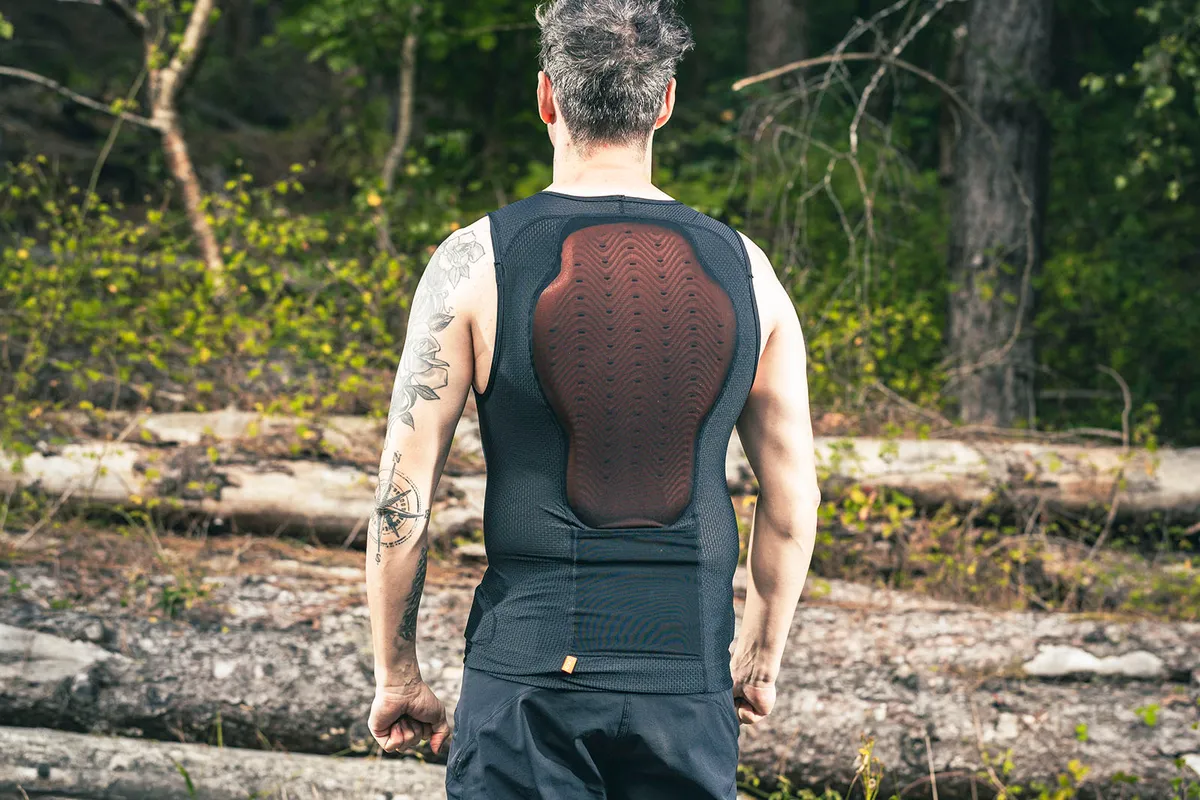
- £150 / $190 / €150 / AU$200 (as tested)
- Pros: Comfortable; decent coverage; secure-feeling
- Cons: Not the easiest to remove
The Baseframe Pro is one of the most comfortable vests we've tested, going mostly unnoticed while riding.
Fox uses a D3O insert, which is well-suited to trail riding.
The Baseframe Pro is barely visible under a jersey, yet gives good coverage with a snug fit that holds the padding in place, without the vest feeling overly tight.
Breathability is very good, but the Baseframe Pro is not as well ventilated as others we've tested. Foam hip pads help fend off scrapes and offer good coverage over the bone.
The storage pocket on the rear of the vest is a little too loose to be useful and it's not the easiest vest to remove.
Spec
Back protection: D3O Viper Stealth (CE L1) | Additional protection: Foam hip pads
SQUIRREL_13195931
Leatt Body Tee AirFlex Stealth
SQUIRREL_TEXT_13086799
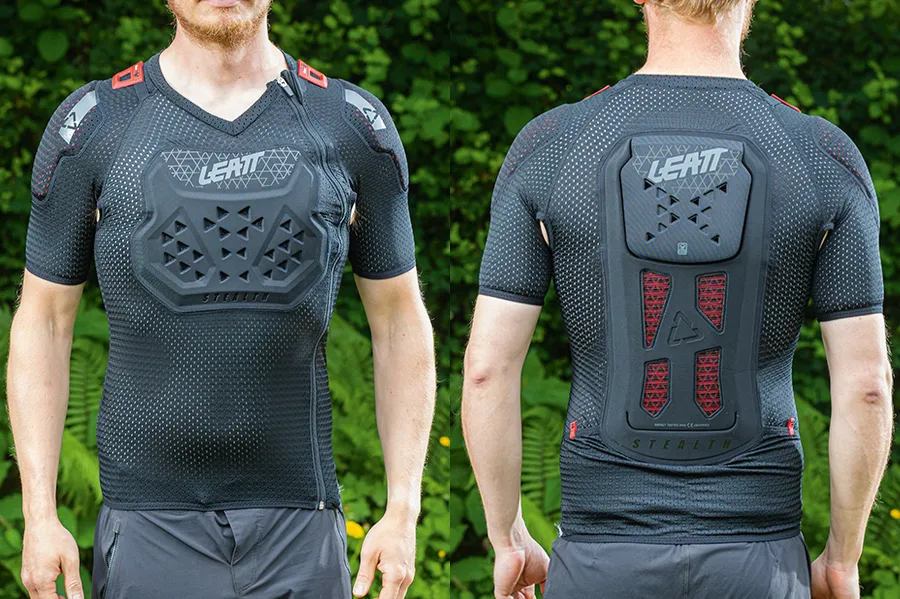
- £190 / $200 (as tested)
- Pros: Comfy for long rides; decent ventilation; good protection
- Cons: Pricey
Leatt’s Body Tee AirFlex Stealth slimline top is light and comfy enough to wear all day, and the open mesh fabric means it doesn’t feel too hot on long climbs.
The AirFlex (soft impact gel) back and shoulder padding provide Level 1 protection – a European safety standard that means the maximum transmitted force must be lower than 18kN with no single value exceeding 24kN.
The large chest panel adds peace of mind, and all are highly flexible.
It’s designed to integrate seamlessly with Leatt’s neck brace, with loops and a removable section of padding at the neck.
An off-centre zip makes putting it on a cinch, and the zip shield prevents any skin irritation. Plus it has two easy-to-access stash pockets.
The only thing that's really holding the Leatt Body Tee back from a full five stars is the price.
Spec
Back protection: AirFlex (CE L1) | Additional protection: Shoulder pads
SQUIRREL_13086799
100% Tarka vest
SQUIRREL_TEXT_13091183
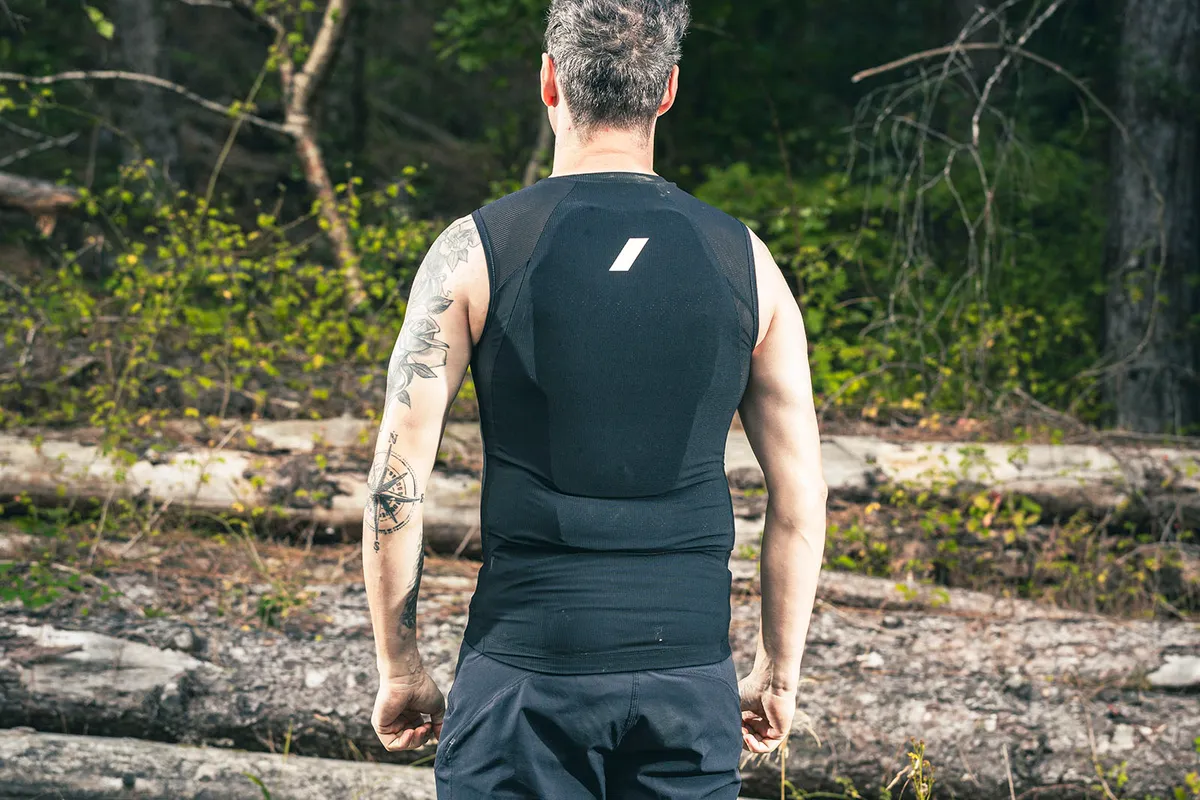
- £140 / $150 (as tested)
- Pros: Secure padding; comfortable fabric; decent coverage
- Cons: Not as breathable as others
The Tarka has a tight fit, which means the padding remains secure when riding, aided by silicone grippers on the hem.
It’s made from stretchy mesh material, which feels good next to your skin, and a side zip makes it easier to get the vest on and off.
The SmartShock impact foam back protector provides ample coverage without interfering with shorts or jerseys, and can be removed for washing.
The chest armour can also be detached for rides that require less protection.
Due to the thick mesh fabric, the Tarka is less breathable, and therefore warmer than other vests.
Spec
Back protection: SmartShock (CE L2) | Additional protection: SmartShock chest (CE L1)
SQUIRREL_13091183
Endura MT500 D3O Protector Vest
SQUIRREL_TEXT_13195943

- £139.99 as tested
- Pros: Ample coverage; built well; good sizing
- Cons: No Level 2 protection; fit issue at front, beneath shoulders
The MT500 D3O Protector Vest is designed for 'the most aggressive DH and trail riding'.
Front and back panels are constructed with ventilated D3O padding, while a highly adjustable neoprene and mesh vest holding it all together.
We found the protector comfortable for long days in the saddle, and while warm it didn't leave us drenched in sweat.
There was a slight fit issue under the shoulder, and considering its weight, we'd love to see a Level 2 back insert to maximise protection.
Spec
Back protection: D3O EN 1621 Level 1 Additional protection: Chest D3O EN 1621 Level 1
- Read more: Endura MT500 D3O Protector Vest review
SQUIRREL_13195943
Also consider…
The following body armour products scored fewer than four out of five stars in testing, so didn't make it into our main list, but they're still worth considering.
7idp Flex Suit
SQUIRREL_TEXT_13092311
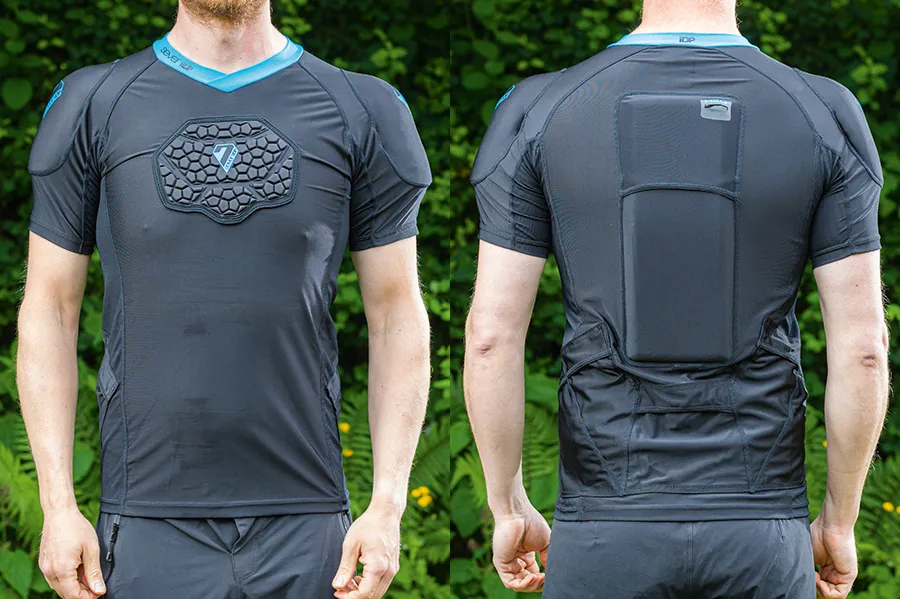
- £110 / $130 (as tested)
- Pros: Confidence-inspiring fit; pockets; can carry hydration bladder
- Cons: Spine guard is too short; overheats
The 7idp Flex Suit has sturdy yet removable shoulder pads that give a real sense of protection, and are pre-formed for comfort and to maximise movement.
This top works well for trail riders, thanks to its lightweight construction and five stash pockets. It’s comfortable to wear without a base layer underneath, and the Level 1 back protector can be replaced with a hydration bladder.
The price is competitive, but there are some compromises. The spine guard isn’t very long and security flaps on the pockets make them tricky to access on the bike. Also, the Flex Suit's material feels clammy when sweaty and doesn’t dry quickly.
Spec
Back protection: Foam (CE L2) | Additional protection: Shoulder pads
SQUIRREL_13092311
Alpinestars Paragon Lite Protection Jacket SS
SQUIRREL_TEXT_13195941
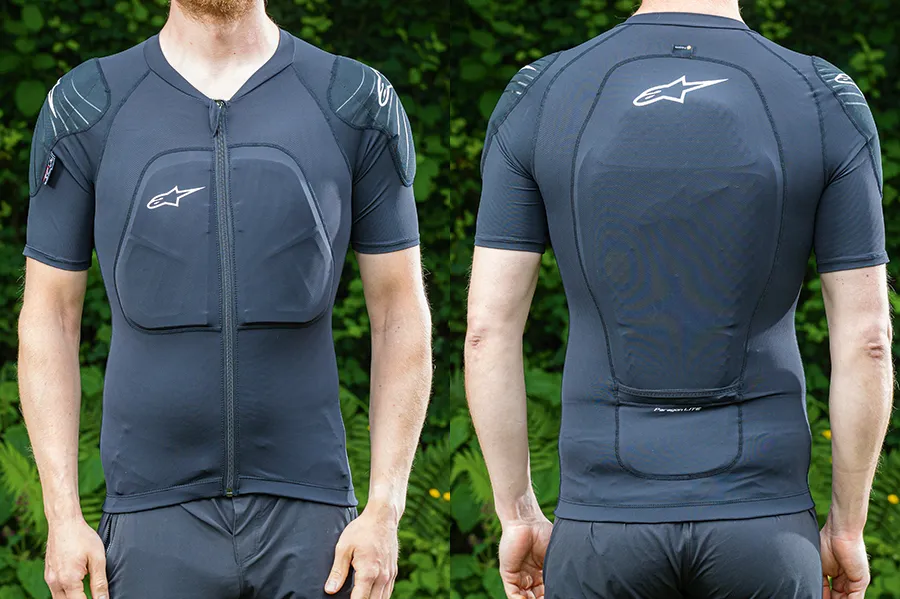
- £140 / $150 (as tested)
- Pros: Decent coverage; flexible fit; secure-feeling; rear pocket
- Cons: Breathability could be better and shoulder pads could be thicker
The Alpinestars Paragon Lite Protection Jacket SS has a CE Level 1-certified back protector, which provides good coverage without being bulky or restrictive, and the chest panel offers good protection too.
It has a good length and fit – snug but not tight under the arms – with a silicone gripper to stop it from riding up at the back, plus a front zip that makes getting it on and off easy. It’s fairly quick-drying and there’s a small rear pocket.
The flexible shoulder pads could be thicker and breathability isn’t the best, though.
We preferred to wear this jacket over a baselayer.
Specs
Back protection: Foam (CE L1) | Additional protection: Shoulder pads
SQUIRREL_13195941
Bluegrass Seamless Lite D3O
SQUIRREL_TEXT_13100786
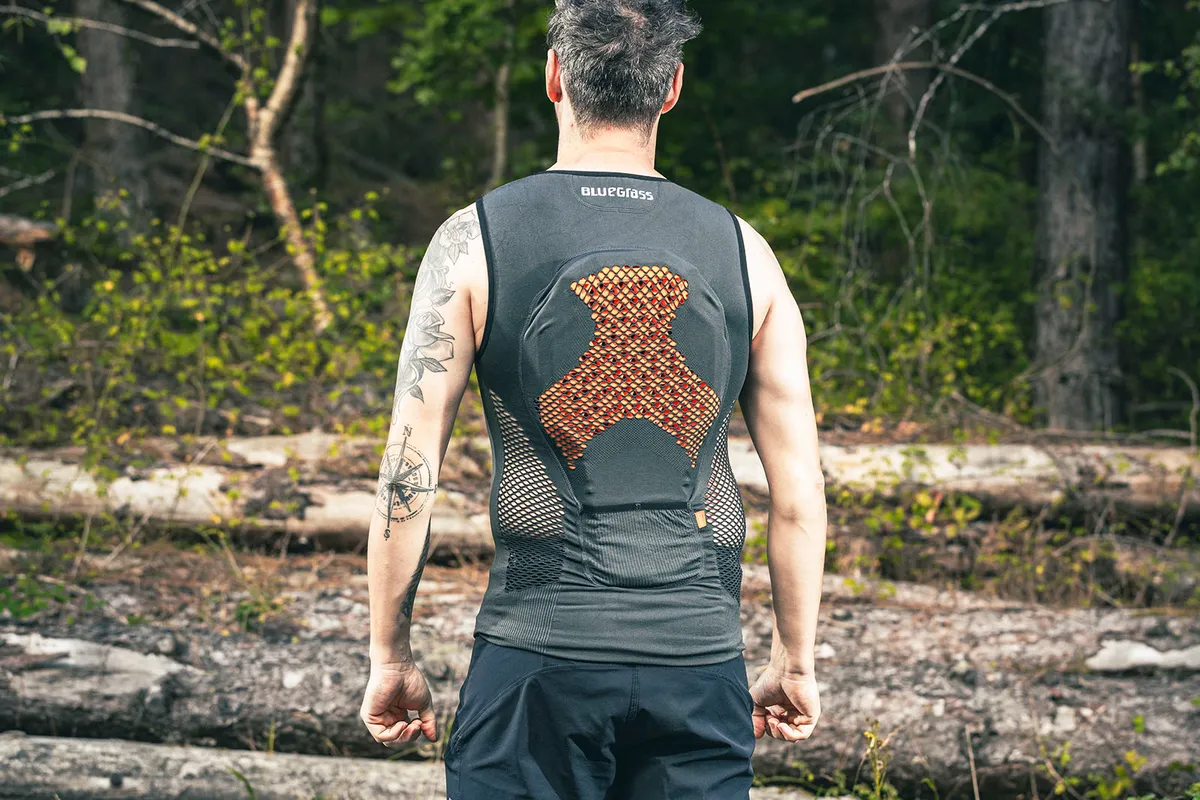
- £170 / €200 (as tested)
- Pros: Great ventilation; secure fit; useful pockets
- Cons: Back protector is too low; padding feels stiff
The Seamless Lite D3O has standout breathability, boasting ample ventilation and wicking sweat well.
A stretchy fabric gives a secure fit without feeling tight, and the vest remains comfy out on the trails. There are two small pockets integrated into the vest which work perfectly for stashing snacks in.
The back protector is a good width, but sits too low down on the back below the shoulder blades.
The D3O feels stiff compared to other padding, and you need to take care when putting the vest on to not tear the mesh.
Spec
Back protection: D3O BP4 (CE L1) | Additional protection: N/A
SQUIRREL_13100786
Ion Tank AMP protection vest
SQUIRREL_TEXT_13096005
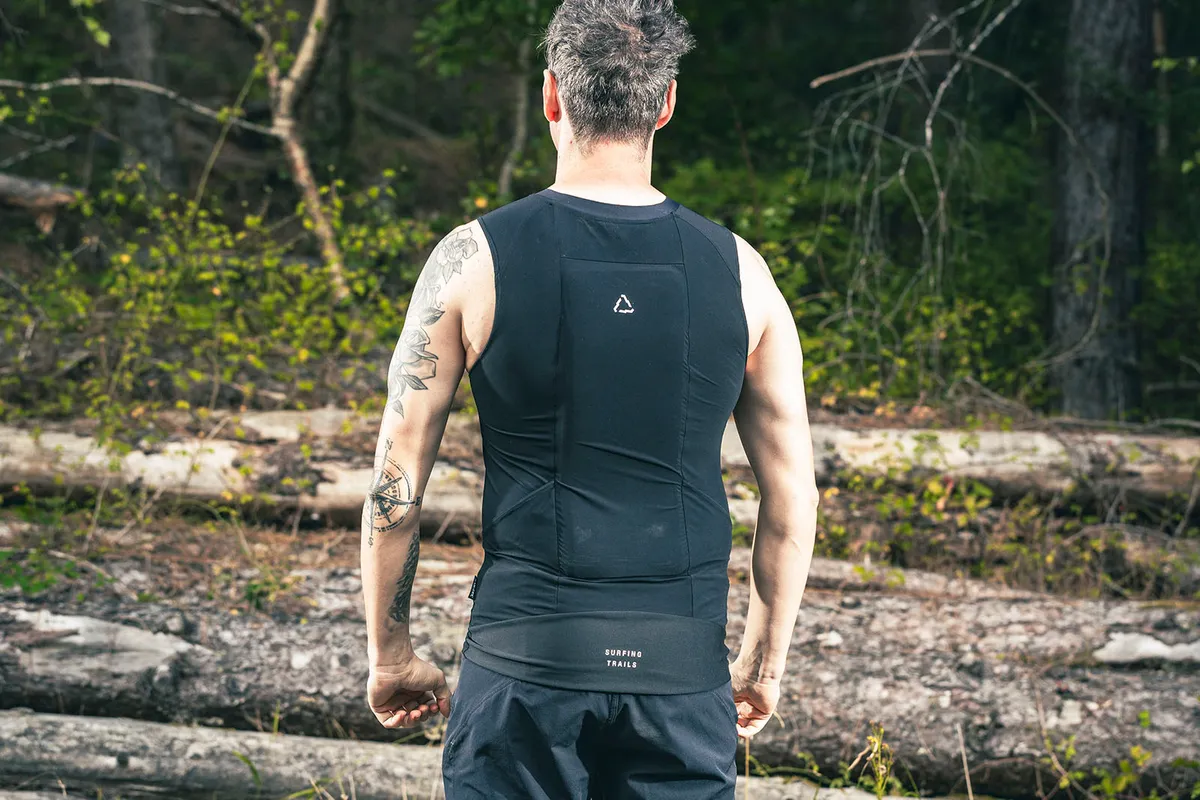
- £135 (as tested)
- Pros: Shapely fit; secure padding; decent pockets
- Cons: Poor breathability; not the beefiest pads
Ion uses a back protector from SAS-TEC, which conforms well to the shape of your body and is barely noticeable under a jersey.
A tight fit helps keep the protection in place, aided by a silicone gripper.
We found the stash pockets useful. This vest works well as a protective base layer but doesn't offer much breathability, with few mesh panels to vent heat.
The protection is also minimal, covering the spine but little else.
Specs
Back protection: SAS-TEC (CE L1) | Additional protection: N/A
SQUIRREL_13096005
How we test mountain bike body armour

We test mountain bike body armour out on the trails to see how it performs in its natural habitat, in bike parks and on enduro trails.
Body armour needs to be worn up as well as down hills, with our team of testers climbing mountains to test breathability and descending hard to see how comfortable the armour is.
Ultimately, we base our mountain bike body armour reviews on the following criteria:
- Comfort – how comfortable is the armour to wear for long durations?
- Protection level – what level of protection the body armour is certified to
- Breathability – how well the body armour vents heat
- Price – how much the body armour costs and how that compares to competitors
Why you can trust BikeRadar
BikeRadar has been an authority on bikes and cycling tech since its inception in 2007, delivering the world’s best riding advice.
We have experts testing all types of bikes, parts, clothing and accessories, from road, mountain and gravel bikes to commuting, bikepacking and electric bikes.
Our reviews are always editorially independent – with no exceptions. Our reviewers comprehensively test all products in the real world, always reflecting on performance, value and the wider market when delivering their verdicts and review ratings.
We have more than 15,000 product reviews available at your fingertips, as well as expert buying, maintenance, training, skills, health and fitness advice.
Our annual Bike of the Year test is an industry benchmark and the BikeRadar team consists of some of the most experienced riders and testers in the business.
Mountain bike body armour buyer’s guide
Do you need MTB body armour?
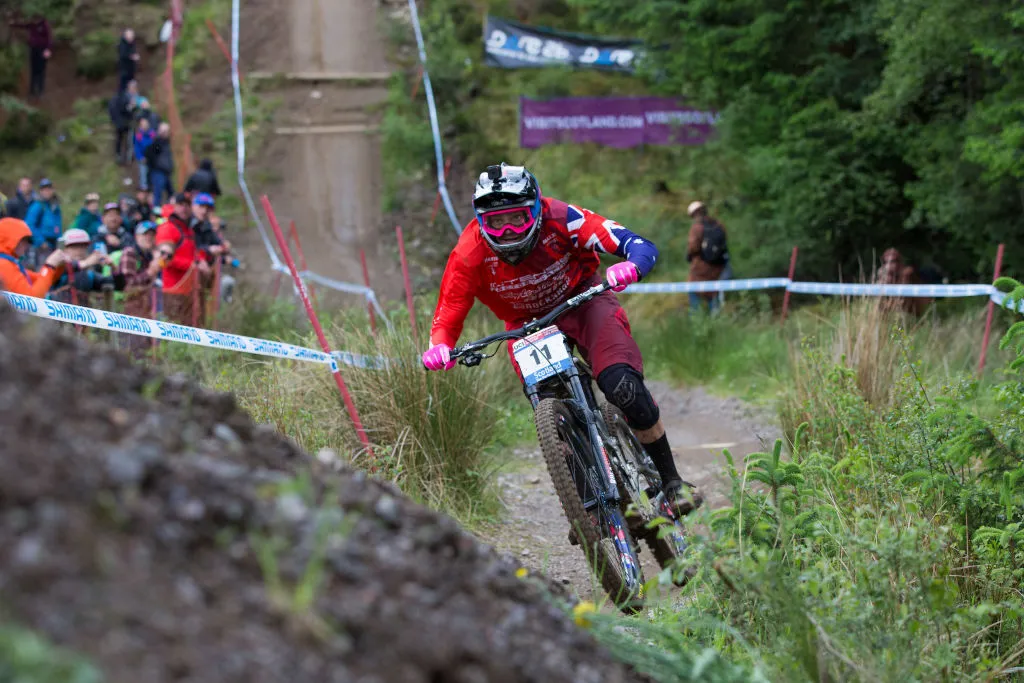
Wearing body armour can help minimise or even prevent injuries when crashing, helping you to keep riding instead of staying at home recovering.
The best mountain bike armour features impact-absorbing pads that don’t take away from your on-bike mobility and will remain breathable on the hottest days when you’re standing at the back of the lift queue.
Many riders choose to wear armour on every ride, while some reserve it for tracks and trails with large jumps or technical features – your choice depends on your attitude towards risk, and how often you crash.
Body armour is less relevant if you are riding cross-country because you're less likely to have the same high-impact crashes you see in enduro racing and downhill riding.
While wearing body armour can add to your confidence, enabling you to overcome features you may have previously had a mental block about, it’s important to be wary of false confidence, because no body armour can protect you from all incidents.
What to look for in MTB body armour
Pad construction
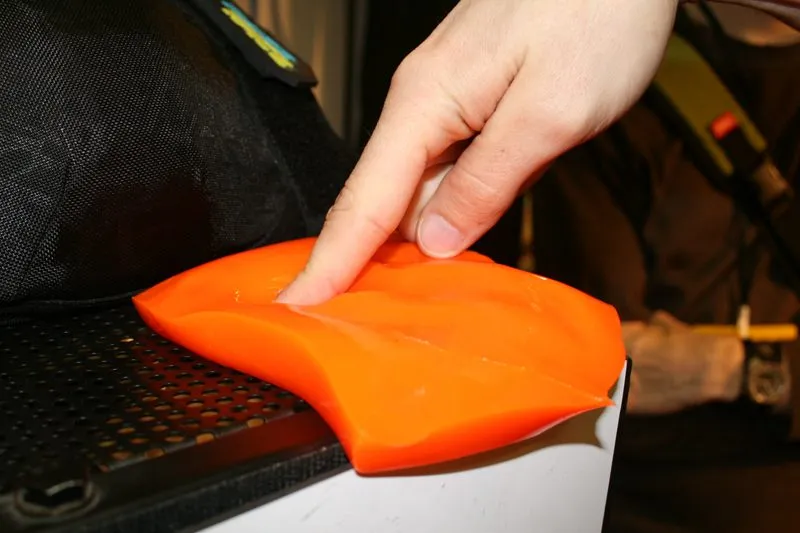
Most body armour will feature non-newtonian impact-hardening polymers, such as D3O, which remain pliable when in normal use and harden up under impact.
For those living in colder climates, these types of pads have the tendency to be a little stiff for the first half-hour of riding, with body heat needed to loosen them up to a malleable state.
Vest material construction
The material used for the vest of the armour is important if you want to avoid overheating.
While the vest needs to be strong to keep pads in place, it's also important it’s breathable, otherwise it will soon end up smelling like Serrano ham in the summer months.
Much of the best body armour will use a stretchy mesh vest for wicking moisture.
Size and fit
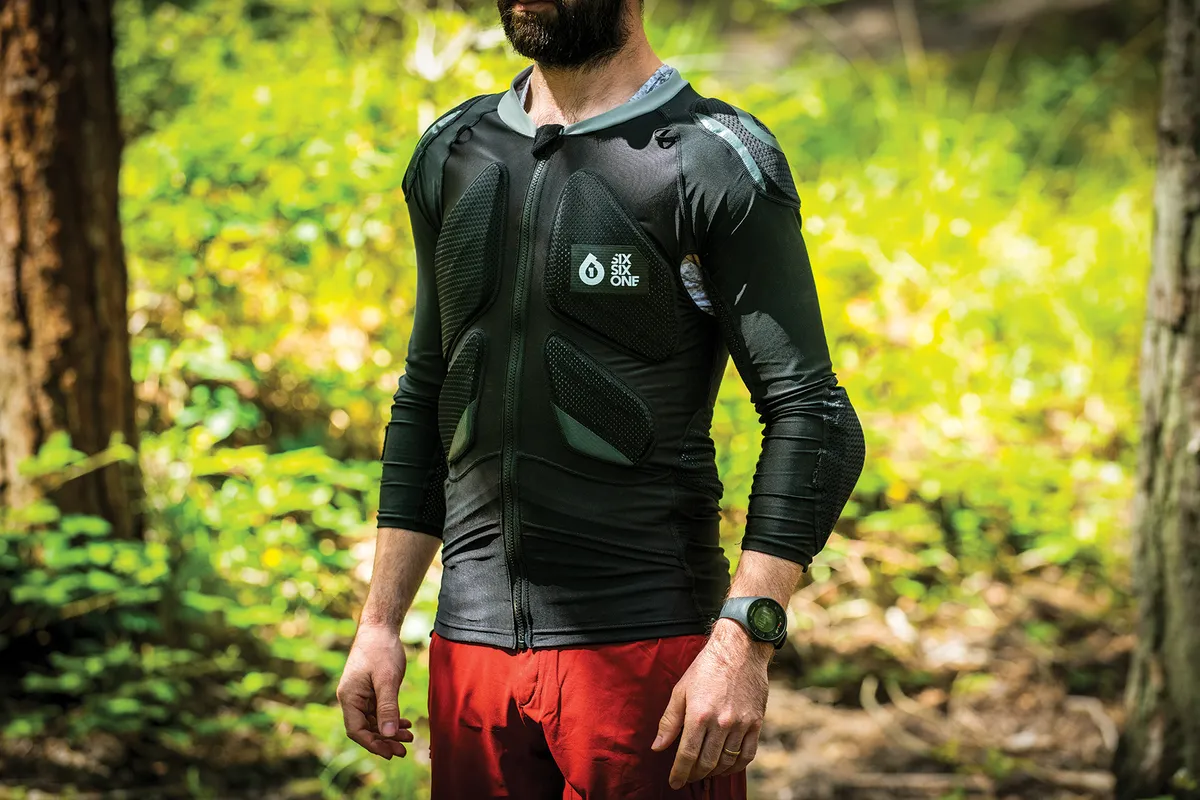
For the pads to be effective, they need to be held in place over the parts of your body they're designed to protect.
A tight fit will reduce the amount of movement from the pads, while making the body armour less obstructive to your movements.
Most body armour is designed to sit below a mountain bike jersey, so the tighter it is the less obvious it will appear.
Protection
Not all body armour offers the same protection, with brands creating discipline-specific body armour to cope with varying demands.
Trail armour is usually the easiest to wear, with less padding and therefore more breathability for longer days in the saddle.
Enduro armour remains comfortable for riding, but features increased padding, while downhill armour has the biggest focus on protection.
Some body armour will have more pads than others to protect your ribs, kidneys, hips and coccyx.
Weight
Weight makes a big difference to how the body armour feels, with heavier items feeling more restrictive to your natural riding position and causing added fatigue.
The best body armour will feel secure when you’re riding without sacrificing comfort.
Certification
All body armour sold in the EU is certified to Level 1 or Level 2, which indicates the amount of force the padding can absorb.
CE Level 1 is rated to transmit a maximum force of 18kN, with no single value exceeding 24kN upon impact.
CE Level 2 is designed for higher impacts and is rated to transmit a maximum force of 9kN, with no single value exceeding 12kN upon impact.
Women's mountain bike body armour
While most body armour is unisex, some brands offer women’s-specific versions of their body armour, featuring a more shapely cut that takes in wider hips, curvier chests and narrower shoulders for a more secure fit.
What other protection do I need for mountain biking?
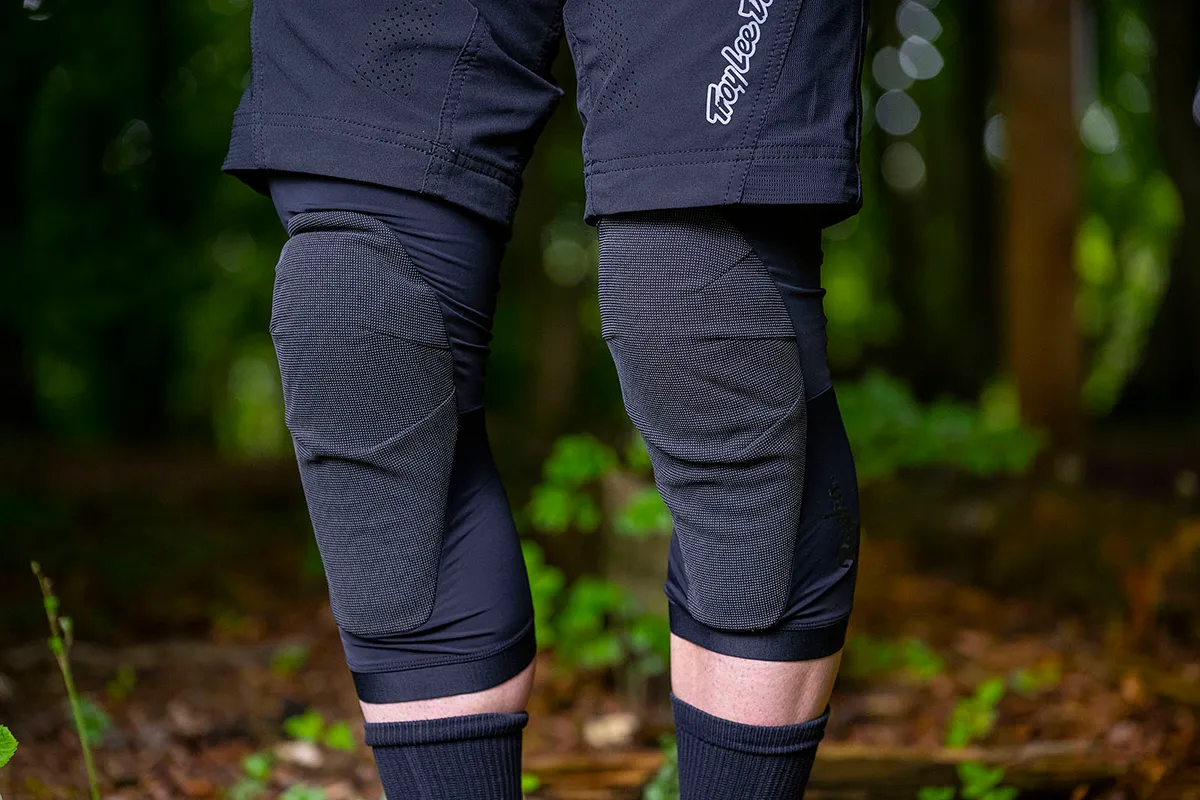
Alongside wearing a mountain bike helmet, we recommend wearing knee pads as a minimum for technical riding because your knees often take the initial impact when you crash.
Elbow pads are also a good idea if you’re hitting the big lines at the bike park, and will save you the indecency of seeing your own bones should you crash.
While many choose to wear skate shoes when riding, these don’t offer much protection. The best mountain bike shoes will have reinforced toe boxes and ankle support to save your feet from rock strikes.
